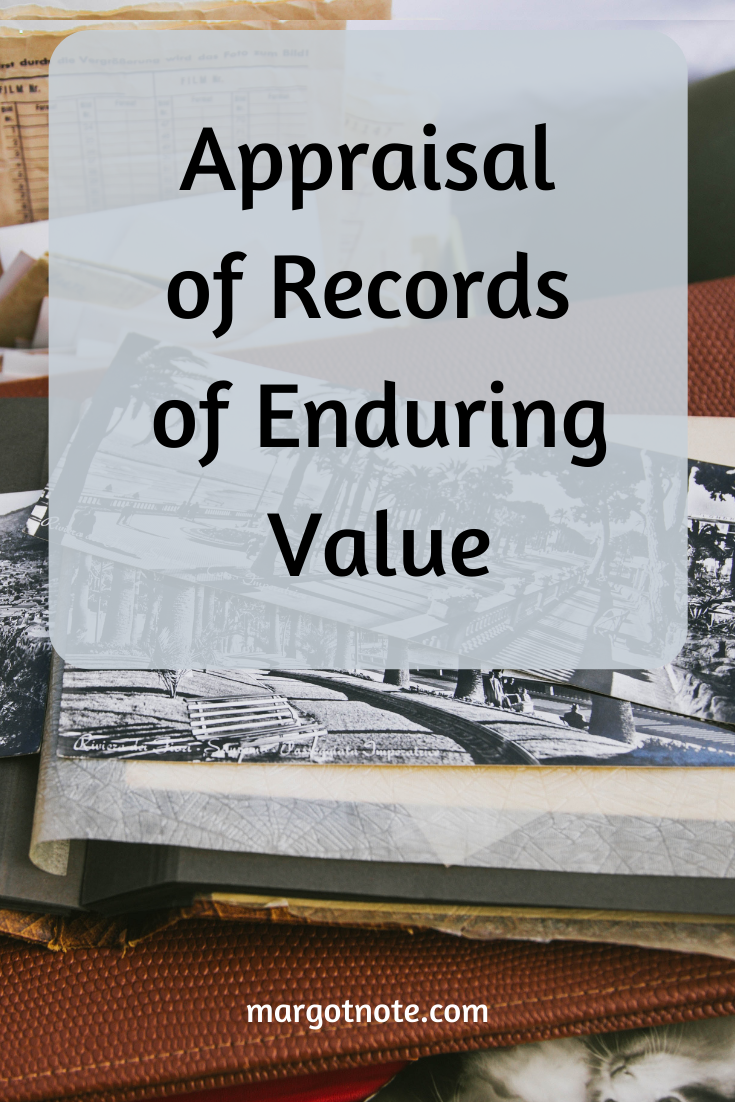Appraisal identifies materials offered to an archives that have sufficient value to be accessioned. It can also be defined as the process of determining the length of time records should be retained, based on legal requirements and their current and potential usefulness.
Selection identifies materials to be preserved because of their enduring value, especially items to be transferred to an archives.
Although the definitions are close, nuances exist. Appraisal often gets confused with monetary appraisal, which archivists must avoid. Selecting is an active verb. One might argue that appraising is active, but it is true that the assessment of value would lead to selecting for acquisition. Selection is also a more concise word for what the archivist does. Archivists are, as is true for other professions, often accused of speaking in code. However, appraisal has become the accepted term for the profession, but selection describes what archivists do. No matter what term is used, institutions utilize a variety of processes and frameworks to build their collections.
The Shape of Selection
Many factors shape appraisal. For example, laws often prescribe what is kept and for how long; laws also often encompass the concept of professional duty to a broader community or group. Another factor is professional norms and issues of accountability that are built into how organizations operate. How well do organizations understand and conduct their functions? How are decisions made and documented?
Appraisal is the archivist’s first responsibility. Subsequent activities hinge on the ability to select wisely. Appraisal requires two tasks. First, archivists must educate themselves about the records of society and improve archival practice accordingly. Appraisal techniques and collecting strategies must be developed to coordinate selection and retention. Second, archivists must educate records creators about the importance of retaining records of long-term importance and inform the public about the essential work of the archival profession to influence and support creators in records preservation.
Three important questions about appraisal exist. What purposes do archivists seek to accomplish when selecting records? When should archivists make their selection? What is the role of context versus content in selection? Whether it be documenting an institution or collecting according to a collection policy, the mission and purpose of an archives play a significant role.
Appraisal Considerations
During appraisal, archivists consider five aspects of the records. The first is their functional characteristics. Who created the record? What was their position, function, or role? The second is content. What is the record about, and how significant is that content? Archivists also consider the potential uses of the records. Who might want to use this information? Are there legal, physical, or intellectual limitations on access? They also consider the context. How can they evaluate these records in the context of other sources? Lastly, they perform a cost-benefit analysis. What is the cost to the repository of acquiring, preserving, and making these records available, relative to value and potential use?
Primary and Secondary Values
Archivists also judge the primary and secondary values of records of enduring value. Primary values include administrative, legal, and fiscal values. Administrative values are the function for which the records were created. Legal value refers to the value for protecting the organization’s legal rights and interests or the rights and interests of other individuals and organizations. Fiscal value is the value for the conduct of the organization’s financial affairs and documentation of its fiscal interests. Most, but not all, primary values diminish with time so that eventually records are not needed for their original purpose.
Secondary values include evidential and informational values. Evidential values document the operation and activities of the record-creating organization, institution, or individual. The three criteria for evidential value include the office’s position in the organizational hierarchy, the function of the office within the organization, and the activities conducted to perform the function. Think of this as evidence documenting the records creators in terms of the policy, operations, activities, and administrative history more than the legal definition of evidence.
Informational values include details about people, places, events, or subjects other than the organization or individual who created the record. Informational values relate more to how archivists look at records as information sources for varied research. Most secondary values do not diminish with time.
This evidential and informational dichotomy points to the different appraisal roles in documenting the history and functions of a specific organization or individual, and documenting society and people, which is much broader.
Making Decisions
Selection is the process of determining whether records have archival value. Appraisal decisions are based on many factors, including the materials’ provenance and content, authenticity and reliability, order and completeness, and their condition and costs to preserve them. Archivists must make decisions to determine what materials have enduring value and deserve preservation over the long term.
The blog was originally published on Lucidea's blog.
GET STARTED
Looking for archival advising, records management, and historical research services? Click below to speak with an expert consultant.































